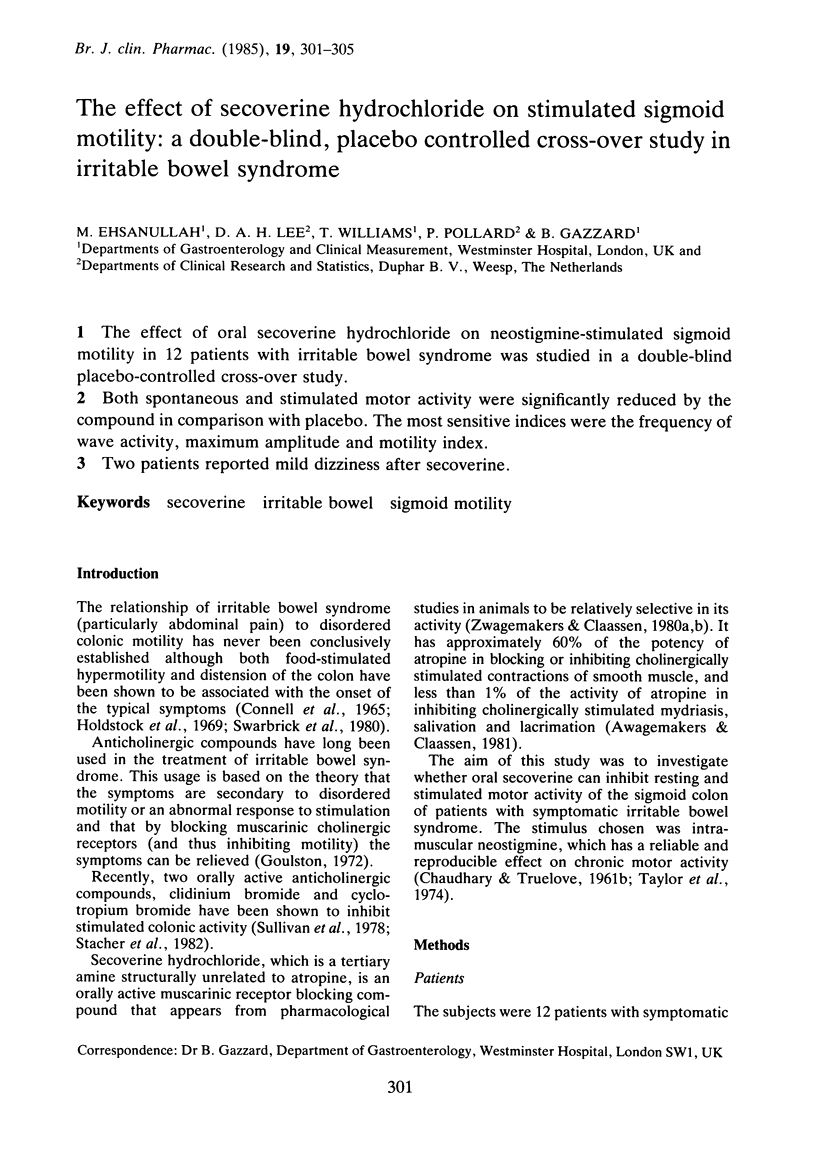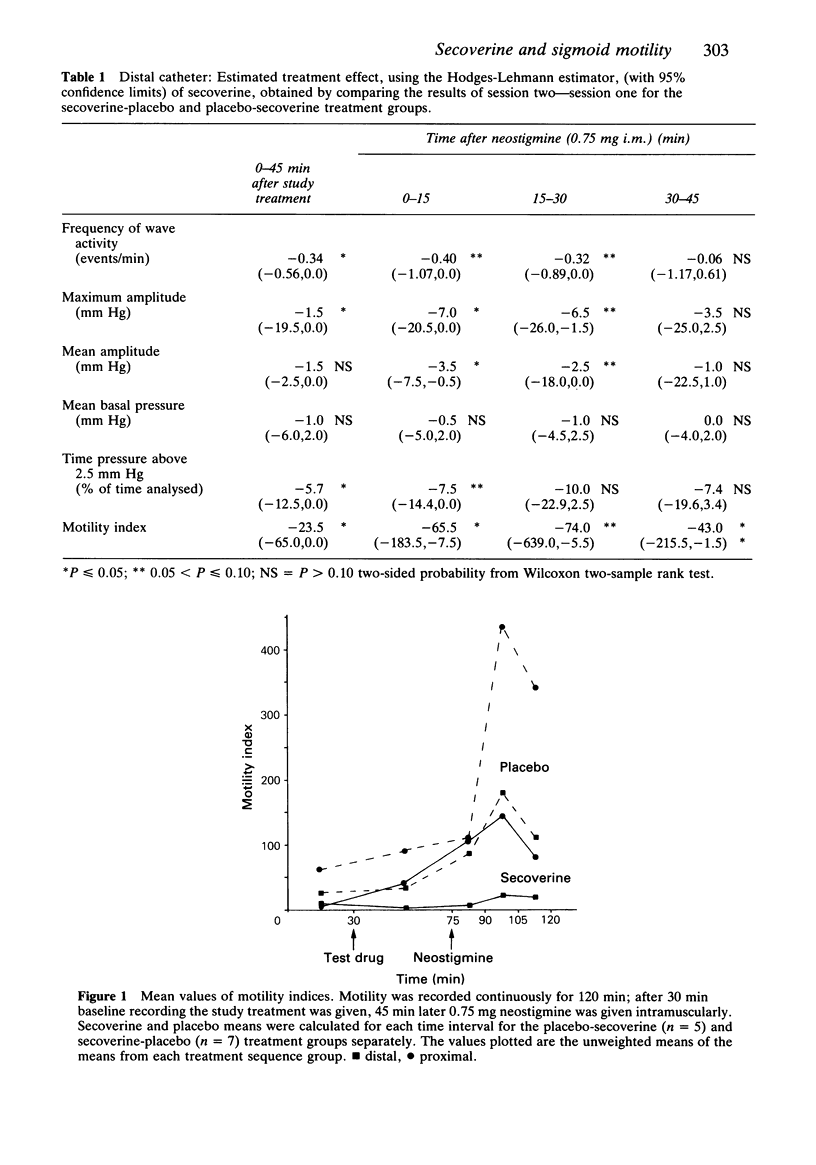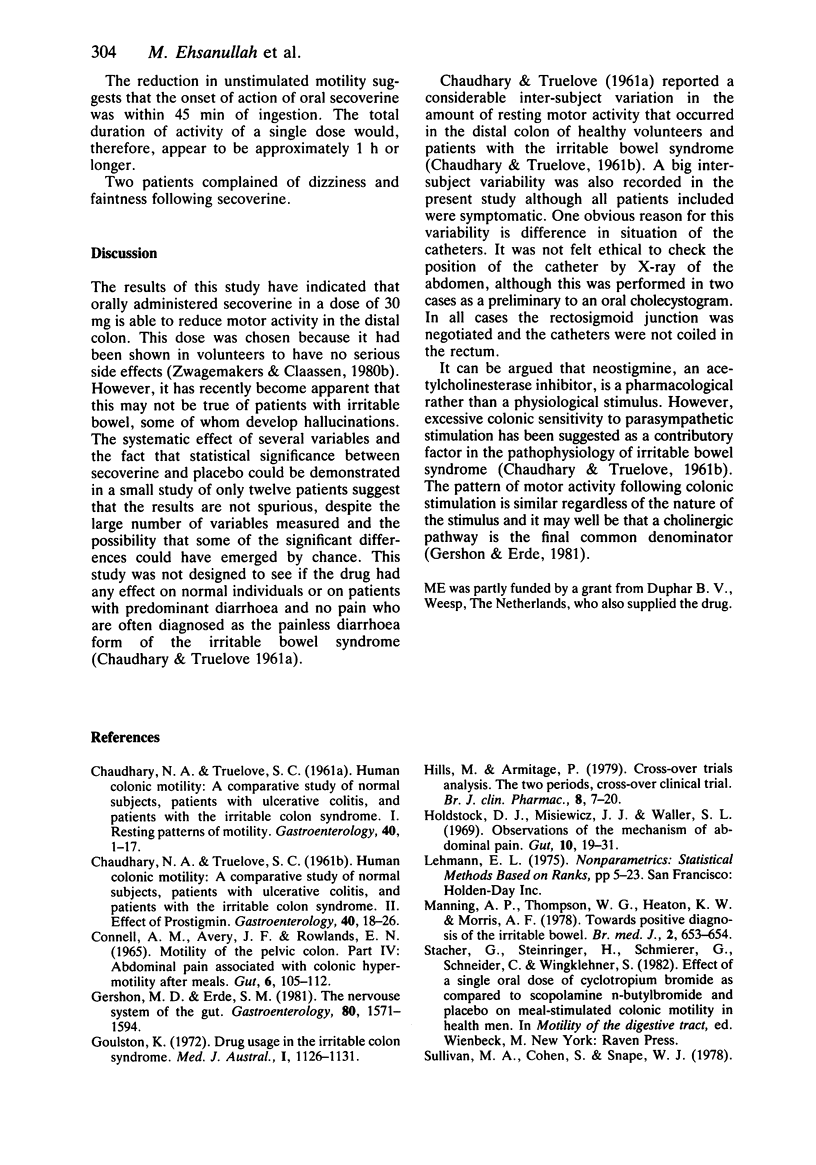Abstract
The effect of oral secoverine hydrochloride on neostigmine-stimulated sigmoid motility in 12 patients with irritable bowel syndrome was studied in a double-blind placebo-controlled cross-over study. Both spontaneous and stimulated motor activity were significantly reduced by the compound in comparison with placebo. The most sensitive indices were the frequency of wave activity, maximum amplitude and motility index. Two patients reported mild dizziness after secoverine.
Full text
PDF




Selected References
These references are in PubMed. This may not be the complete list of references from this article.
- CHAUDHARY N. A., TRUELOVE S. C. Human colonic motility: a comparative study of normal subjects, patients with ulcerative colitis, and patients with the irritable colon syndrome. I. Resting patterns of motility. Gastroenterology. 1961 Jan;40:1–17. [PubMed] [Google Scholar]
- CHAUDHARY N. A., TRUELOVE S. C. Human colonic motility: a comparative study of normal subjects, patients with ulcerative colitis, and patients with the irritable colon syndrome. II. The effect of prostigmin. Gastroenterology. 1961 Jan;40:18–26. [PubMed] [Google Scholar]
- CONNELL A. M., JONES F. A., ROWLANDS E. N. MOTILITY OF THE PELVIC COLON. IV. ABDOMINAL PAIN ASSOCIATED WITH COLONIC HYPERMOTILITY AFTER MEALS. Gut. 1965 Apr;6:105–112. doi: 10.1136/gut.6.2.105. [DOI] [PMC free article] [PubMed] [Google Scholar]
- Gershon M. D., Erde S. M. The nervous system of the gut. Gastroenterology. 1981 Jun;80(6):1571–1594. [PubMed] [Google Scholar]
- Goulston K. Drug usage in the irritable colon syndrome. Med J Aust. 1972 May 27;1(22):1126–1131. [PubMed] [Google Scholar]
- Hills M., Armitage P. The two-period cross-over clinical trial. Br J Clin Pharmacol. 1979 Jul;8(1):7–20. doi: 10.1111/j.1365-2125.1979.tb05903.x. [DOI] [PMC free article] [PubMed] [Google Scholar]
- Holdstock D. J., Misiewicz J. J., Waller S. L. Observations on the mechanism of abdominal pain. Gut. 1969 Jan;10(1):19–31. doi: 10.1136/gut.10.1.19. [DOI] [PMC free article] [PubMed] [Google Scholar]
- Manning A. P., Thompson W. G., Heaton K. W., Morris A. F. Towards positive diagnosis of the irritable bowel. Br Med J. 1978 Sep 2;2(6138):653–654. doi: 10.1136/bmj.2.6138.653. [DOI] [PMC free article] [PubMed] [Google Scholar]
- Sullivan M. A., Cohen S., Snape W. J., Jr Colonic myoelectrical activity in irritable-bowel syndrome. Effect of eating and anticholinergics. N Engl J Med. 1978 Apr 20;298(16):878–883. doi: 10.1056/NEJM197804202981604. [DOI] [PubMed] [Google Scholar]
- Swarbrick E. T., Hegarty J. E., Bat L., Williams C. B., Dawson A. M. Site of pain from the irritable bowel. Lancet. 1980 Aug 30;2(8192):443–446. doi: 10.1016/s0140-6736(80)91885-1. [DOI] [PubMed] [Google Scholar]
- Taylor I., Duthie H. L., Smallwood R., Brown B. H., Linkens D. The effect of stimulation on the myoelectrical activity of the rectosigmoid in man. Gut. 1974 Aug;15(8):599–607. doi: 10.1136/gut.15.8.599. [DOI] [PMC free article] [PubMed] [Google Scholar]
- Zwagemakers J. M., Claassen V. Pharmacology of secoverine, a new spasmolytic agent with specific antimuscarinic properties. Part 1: Antimuscarinic and spasmolytic effects. Arzneimittelforschung. 1980;30(9):1517–1526. [PubMed] [Google Scholar]
- Zwagemakers J. M., Claassen V. Pharmacology of secoverine, a new spasmolytic agent with specific antimuscarinic properties. Part 2: General pharmacological properties. Arzneimittelforschung. 1980;30(9):1526–1534. [PubMed] [Google Scholar]
- Zwagemakers J. M., Claassen V. Secoverine selectively antagonizes muscarinic effects in various in vivo preparations. Eur J Pharmacol. 1981 Apr 24;71(1):165–168. doi: 10.1016/0014-2999(81)90403-9. [DOI] [PubMed] [Google Scholar]


